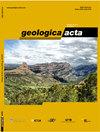Cadomian metabasites of the Eastern Pyrenees revisited
IF 2
4区 地球科学
Q2 GEOLOGY
引用次数: 0
Abstract
This study presents a new geochemical, petrological, and geochronological U–Pb dataset from Ediacaran metabasites of the Canigó and Cap de Creus massifs, Eastern Pyrenees. The rocks are composed of calcic amphibole + plagioclase + chlorite + epidote ± quartz plus titanite + apatite + ilmenite ± biotite ± rutile as accessory phases and show relict igneous textures. Peak pressure-temperature determinations share common conditions, ranging 452–482ºC and 5.2–7.7kbar. These intermediate P-T conditions suggest Barrovian-type metamorphism, most likely related to a collisional setting. The metabasites correspond to evolved basaltic rocks (Mg#<0.55) with moderate TiO2 content (up to 2.08wt.%) and relatively low Cr (43–416ppm). The rocks are moderately enriched in light rare earth elements (LREE) relative to heavy rare earth elements (HREE) (average (La/Lu)n of 2.7) and the N-MORB normalized multi-element patterns show negative slopes, with prominent negative Nb anomalies ((Nb/La)NMORB=0.33–0.78). These variations are akin to island arc tholeiites generated in back-arc basins and to other metabasites described in the Eastern Pyrenees with a putative Ediacaran age, and they differ from the Ordovician tholeiitic metabasites from the Canigó massif, which derived from a contaminated E-MORB source. The positive ƐNd(T) values (0.82–3.05) of the studied metabasites preclude a notable contribution from an older continental crust. U-Pb dating (LA-ICP-MS) of one chlorite-rich schist sample in contact with the metabasites from the Canigó massif yielded a main peak at ca. 632Ma. We argue that the Cadomian metabasites from the Pyrenees formed during back-arc extension in the continental margin of Gondwana and were later affected by (probably early Variscan) medium-P metamorphism before the HT-LP metamorphism classically described in the Pyrenees.东比利牛斯山脉卡多米亚变质岩重访
本文介绍了东比利牛斯山脉Canigó和Cap de Creus地块埃迪卡拉纪变质岩中新的地球化学、岩石学和年代学U-Pb数据集。岩石由钙质角闪洞+斜长石+绿泥石+绿帘石+石英+钛矿+磷灰石+钛铁矿+黑云母±金红石为副相组成,呈残余火成岩结构。峰值压力-温度测定具有共同的条件,范围为452-482ºC和5.2-7.7kbar。这些中间的P-T条件表明巴罗维亚型变质作用,很可能与碰撞环境有关。变质岩为演化玄武岩(Mg#<0.55), TiO2含量适中(2.08wt.%), Cr含量较低(43 ~ 416ppm)。岩石轻稀土元素(LREE)相对重稀土元素(HREE)中等富集(平均(La/Lu)n为2.7),n - morb归一化多元素模式呈负斜率,负Nb异常显著((Nb/La)NMORB=0.33 ~ 0.78)。这些变化类似于弧后盆地中的岛弧拉斑岩和东比利牛斯山脉中描述的其他假定埃迪卡拉纪时代的变质岩,而不同于Canigó地块中来自受污染的E-MORB源的奥陶系拉斑岩变质岩。研究的变质岩的正ƐNd(T)值(0.82-3.05)排除了较老大陆地壳的显著贡献。对一个与Canigó地块中变质岩接触的富绿泥石片岩样品进行了LA-ICP-MS定年,得到了一个约632Ma的主峰。我们认为,来自比利牛斯山脉的卡多米尼亚变质岩形成于冈瓦纳大陆边缘弧后伸展时期,并在比利牛斯山脉经典描述的高温-低温变质作用之前受到(可能是早Variscan)中磷变质作用的影响。
本文章由计算机程序翻译,如有差异,请以英文原文为准。
求助全文
约1分钟内获得全文
求助全文
来源期刊

Geologica Acta
地学-地质学
CiteScore
2.50
自引率
6.70%
发文量
13
审稿时长
>12 weeks
期刊介绍:
- Relevant conceptual developments in any area of the Earth Sciences.
- Studies presenting regional synthesis.
- Thematic issues or monographic volumes presenting the results from one or more research groups.
- Short papers reflecting interesting results or works in progress.
- Contributions and results from Research Projects, Workshops, Symposiums, Congresses and any relevant scientific activity related to Earth Sciences.
- Geologica Acta aims to stimulate rapid diffusion of results and efficient exchange of ideas between the widespread communities of Earth Science researchers (with special emphasis on Latinamerica, the Caribbean, Europe, the Mediterranean
 求助内容:
求助内容: 应助结果提醒方式:
应助结果提醒方式:


